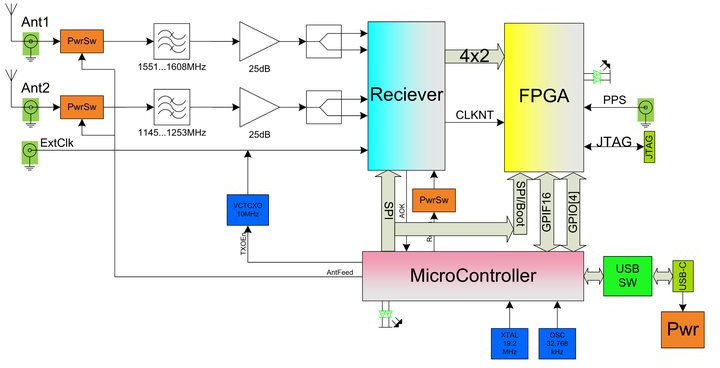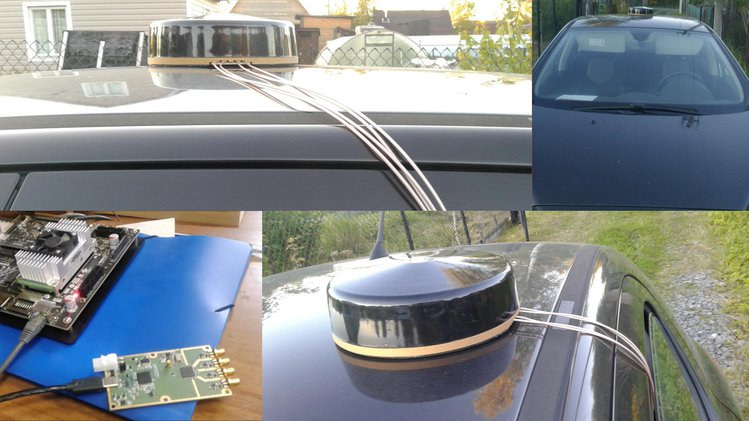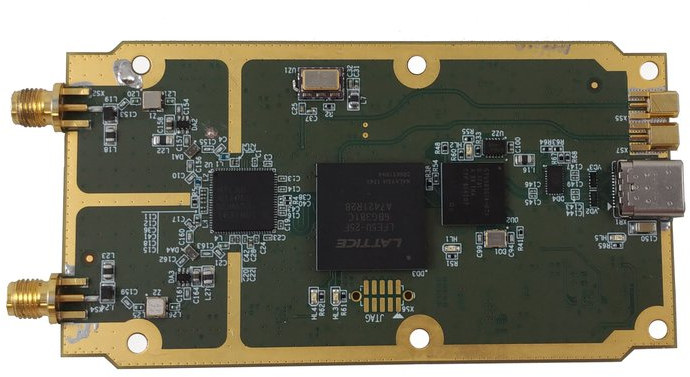Amungo Navigation NUT2NT+ is an open-source hardware four-channel, all-frequency, GNSS RF-to-bits receiver for precision, satellite-based positioning. Connected to the right antennas, the board can achieve centimeter positioning resolution by connecting to multiple navigation satellite systems including GPS, GLONASS, Galileo, BeiDou, and IRNSS.
Amungo claims that while several startups and large companies already offer proprietary GNSS positioning solutions NUT2NT+ is the only open source option in this class of GNSS devices.
NUT2NT+ key features and specifications:
- Receiver chip – NTLab NT1065 4-Channel RF Front-End IC
- FPGA – Lattice ECP5 with 12K LUTs + 28 DSP blocks (LFE5U-12) opened for custom design
- USB – 1x USB 3.1 Type-C port via CYUSB3014 USB 3.0 controller:
- Clock – 10 MHz TCXO, soldered
- RF inputs – 2x bands dedicated; – 5 dB referred noise floor
- ADC – 2-bit resolution up to 99 MHz
- Samples transfer – Continuous full stream, from 10 to 50 Mbytes/sec
- GNSS
- Standards – GPS, GLONASS, Galileo, BeiDou, IRNSS, and future standards
- Band: L1/L2/L3/L5, G1/G2/G5, B1/B2, E1/E5, and future bands
- Power injector circuit – For antennas with a DC short like a dipole or PIFA. The circuit is software-controllable.
- Power consumption – 5 V/0.3 A from USB
- Dimensions – 100 x 50 x 10 mm
 The board comes with optional enclosures and antennas, as well as open-source software for spectrum and GNSS signal monitoring, USB controller firmware, and FPGA code which you’ll find on Github.
The board comes with optional enclosures and antennas, as well as open-source software for spectrum and GNSS signal monitoring, USB controller firmware, and FPGA code which you’ll find on Github.
Some of the applications made possible by this board include a GNSS Sensor for autonomous driving when combined with an RA125 antenna and Jetson TX2 board, or a GNSS multi-band “Black Box” Logger with RockPro64 or other small factor SBCs.

NUT2NT+ GNSS board launched on Crowd Supply a few days ago with a $15,000, and so far they’ve reached a little over half of the target. Rewards now start at $320 for an NUT2NT+ board only, but you may also consider adding accessories such as antennas ($80 and up), $20 for an RF cable connecting to the antenna, or enclosures. Shipping for the board is free to the US but adds $30 to the rest of the world, and backers can expect their kit to be shipped by the end of September 2019 if everything goes according to plan.

Jean-Luc started CNX Software in 2010 as a part-time endeavor, before quitting his job as a software engineering manager, and starting to write daily news, and reviews full time later in 2011.
Support CNX Software! Donate via cryptocurrencies, become a Patron on Patreon, or purchase goods on Amazon or Aliexpress. We also use affiliate links in articles to earn commissions if you make a purchase after clicking on those links.






I’m interested in the use as a timing device as well.
Would not it be possible to create a timing device with something much less expensive?
@cnxsoft: “Would not it be possible to create a timing device with something much less expensive?”
For hobbyists and/or very low volume users, yes…
There used to be a lot of surplus GPS disciplined ovenized crystal oscillators (VCOCXO’s) on Ebay fairly cheap (e.g. Trimble Thunderbolt and Thunderbolt-E models), but they’re getting harder to find and more expensive ($100-$200 USD) these days. Most of them came from decommissioned cellular base stations. However you might get a weird output frequency, like if the oscillator was used as a reference in a CDMA base station. Here is a $119 example:
https://www.ebay.com/itm/Trimble-GPS-Receiver-GPSDO-10MHz-1PPS-GPS-Disciplined-Clock/262401923665?hash=item3d185f9a51:g:kXgAAOSwjDZYmrfD
Here is the “Lady Heather’s Disciplined Oscillator Control Program” most people use to monitor and control these GPS references (there is a list of compatible devices at the link below):
http://www.ke5fx.com/heather/readme.htm
I’ve also seen some GPS disciplined VCOCXO/VCTCXO references sold new on Tindie and Ebay, but they are not really industrial grade. Here is one example for $135 USD:
https://www.tindie.com/products/nhbbobb/10mhz-gps-disciplined-frequency-reference/
Another good option is to buy a used/surplus Rubidium reference oscillator from Ebay and discipline it via GPS. Here is a $99 ready-built board that does this:
https://www.tindie.com/products/nsayer/fe-5680a-gps-discipline-module/
The price for Rubidium oscillators varies widely depending on the type, model and condition. Two examples, $85.10 & $173.99:
https://www.ebay.com/itm/FEI-FE-5650A-Option-58-programmable-Rubidium-Oscillator-change-Freq-on-pc/291700649031?hash=item43eab6ac47
https://www.ebay.com/itm/1PC-USED-FE-5680A-Rubidium-atomic-clock-Tested/173596153838?epid=1633675263&hash=item286b2317
There are some fairly inexpensive (in volume) GPS disciplined reference modules from the likes of Trimble and Connor-Winfield, but they are hard to get unless you want to buy a lot of them. Plus they get expensive fast as the phase-noise (jitter) specifications get better. For example:
http://www.conwin.com/time-frequency_references-gps_disciplined-gps_references.html
Or if all you are interested in is accurate human readable daytime, just look at your cell phone. The phone’s time is synchronized over the Internet to what is a termed a “Stratum-1” time server somewhere (there are many of them) using the Network Time Protocol (NTP v.4, IETF RFC 5905,6,7,8), or similar:
http://support.ntp.org/bin/view/Main/WebHome
@Jim st: From the block diagram it seems they did not GPS discipline the on board 10MHz oscillator (a TCXO not a VCTCXO). That is an amazing omission IMO.